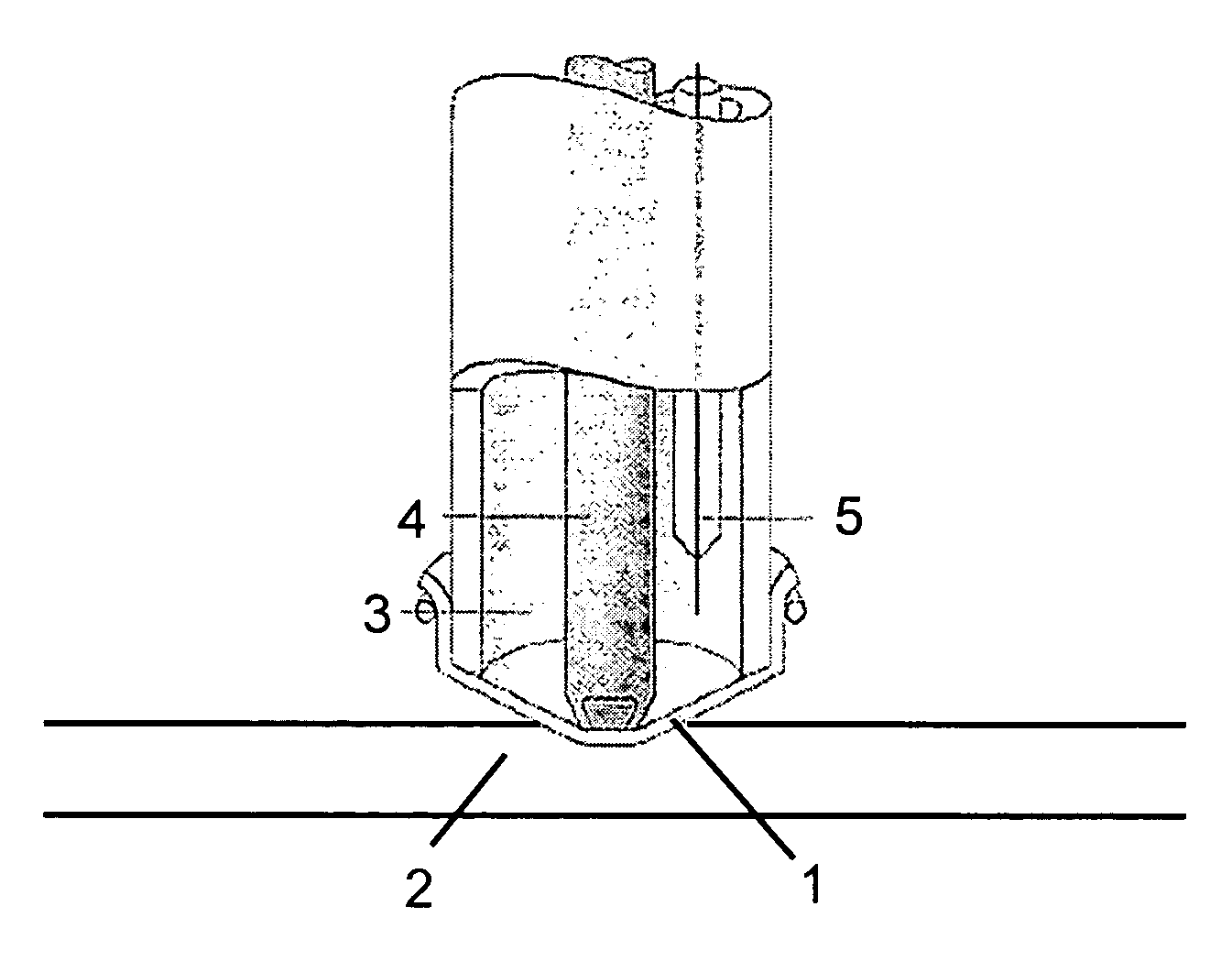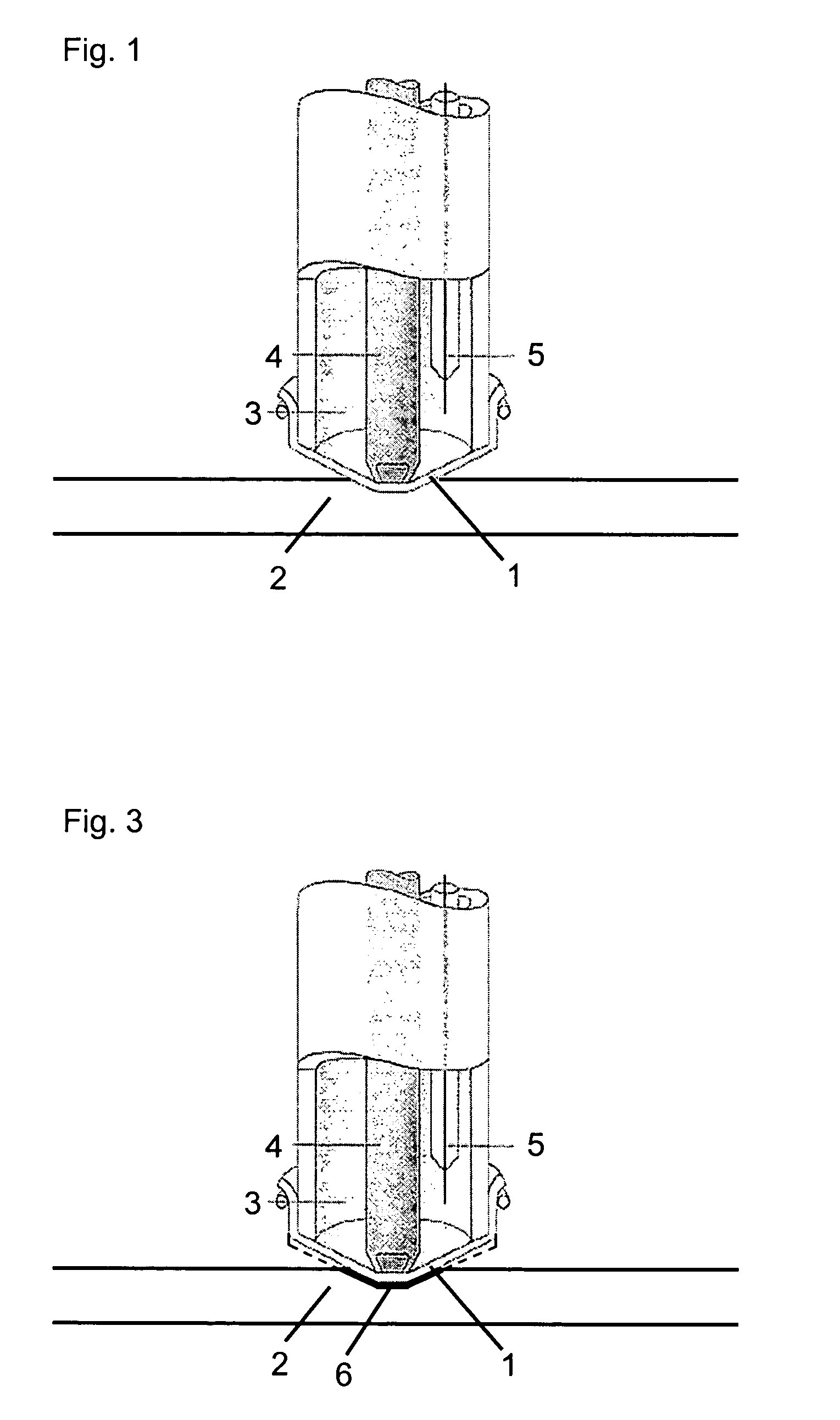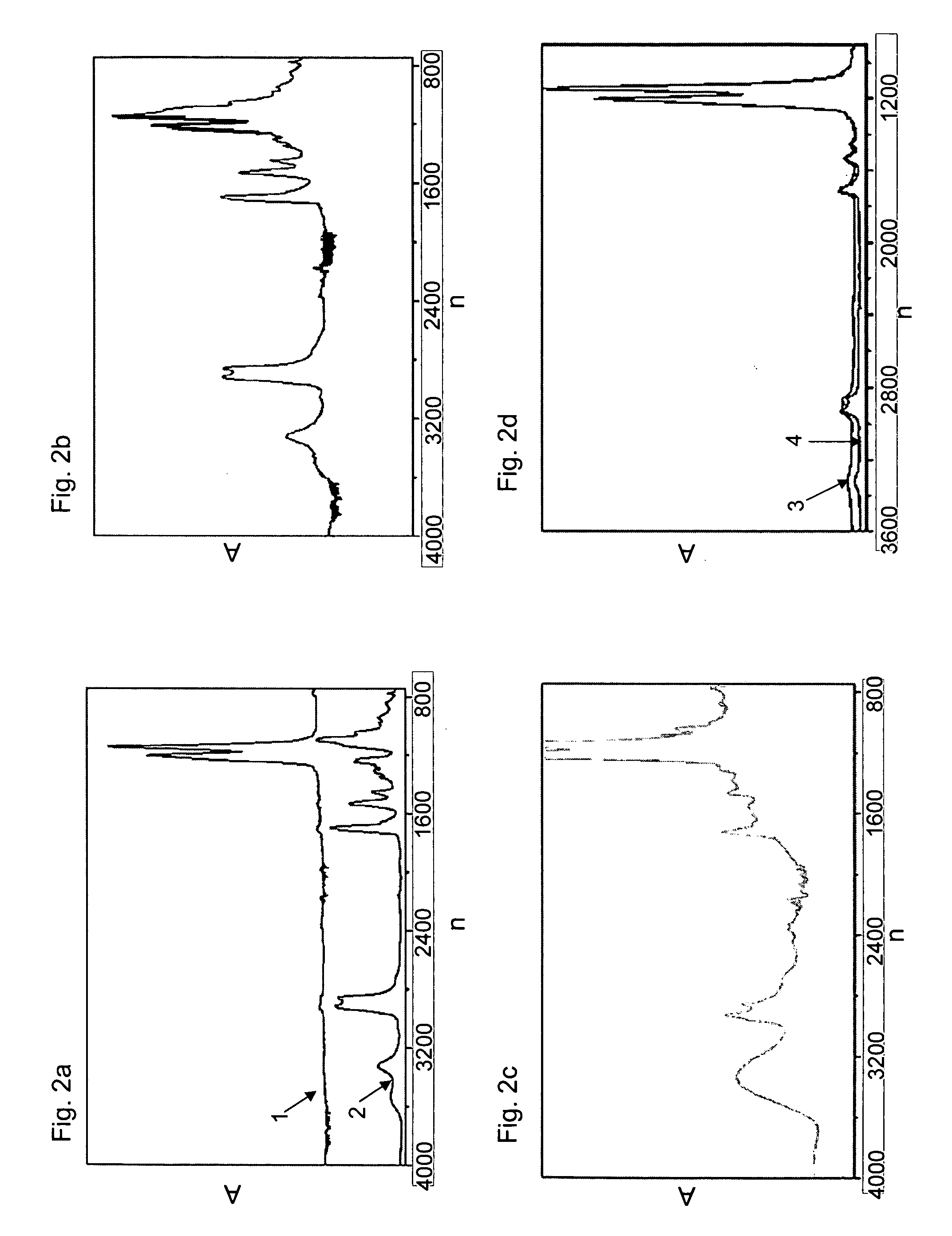[0039] In a typical embodiment of the present invention, the film applied to the membrane consists of a hydrophilic
polymer which is soluble in certain organic solvents and
solvent mixtures and is substantially insoluble in aqueous solutions and, in particular, in the aqueous outer solutions and sample liquids. In particular, the use of such
hydrophilic polymers enables the membrane to be coated rationally and efficiently with a film of such a hydrophilic polymer in a long-lasting and durable manner without additional
chemical reaction steps. The
coating can for example be carried out by firstly dissolving the hydrophilic polymer in an
organic solvent or
solvent mixture, subsequently applying this
polymer solution to the parts of the membrane to be coated, removing any excess of
polymer solution such that a certain amount of
polymer solution remains on the membrane, and finally removing the
organic solvent or
solvent mixture of the polymer solution that is on the membrane such that a film of the hydrophilic polymer remains on the membrane. In addition, it is possible to specifically define and adjust the thickness of the film of hydrophilic polymer applied to the membrane by adjusting the amount and / or concentration of the polymer solution remaining on the membrane. Hence,
hydrophilic polymers can be used which are composed of non-covalently cross-linked polymer chains. These can be produced by the process described above. A major
advantage of the present invention is that the hydrophilic polymer not have to be produced only on the
coated membrane but rather the hydrophilic polymer chains can already be applied to the membrane in an essentially ready-to-use solution. This distinguishes the present invention especially from hydrophilic coatings that are produced by polymerizing monomers, especially by
plasma polymerization, on a base membrane since the method according to the invention which uses already polymerized
hydrophilic polymers that are essentially composed of non-covalently cross-linked polymer chains does not required complicated
polymerization steps. The use of such hydrophilic polymers enables a
hydrophilic coating to be produced directly and simply without additional
chemical reaction steps. For this purpose the polymer chains do not necessarily have to be cross-linked with one another in order to achieve a durable
hydrophilic coating. By using longer-chained polymers they can arrange to form a durable film of a hydrophilic polymer even without covalent cross-linkings.
[0040] The substantial insolubility of the hydrophilic polymer in aqueous solutions and especially in aqueous outer solutions and sample liquids further improves the stability of the hydrophilic polymer film. Hence, the durability of the film can be increased especially when such membranes provided with a film of a hydrophilic polymer are used in electrochemical gas sensors in diagnostic analytical systems such as blood gas analyzers. Frequent contact with aqueous solutions, for example due to the repeated process of filling and emptying the sample channel as is common in such blood gas analytical systems, can reduce the
layer thickness of the film over time due to a continuous
dissolution of the film of hydrophilic polymer. Such a
dissolution of the polymer film can be avoided to a considerable extent by using hydrophilic polymers that are substantially insoluble in aqueous solutions so that such films have an increased life-time and are thus typically suited for use in such analytical systems.
[0041] In another typical embodiment of the present invention, the film present on the membrane comprises a polyether-
polyurethane copolymer. Such polyether-
polyurethane copolymers are described for example in the U.S. Pat. Nos. 5,728,762 and 5,932,200, both to Reich et al., the discosures of which are hereby incorporated by reference for their teaching of polyether-
polyurethane copolymers. Such hydrophilic polymers are surprisingly especially suitable for an inventive
coating of a membrane with a film of a hydrophilic polymer. Such typical polyether-polyurethane copolymers are block copolymers with hydrophilic regions and hydrophobic regions. As a result of these amphiphilic properties the polymers dissolve well in certain organic solvents and solvent mixtures, on the other hand they organize themselves after removal of the
organic solvent or solvent mixtures to form hydrogels with hydrophilic surface properties that are substantially insoluble in aqueous solutions and are thus particularly suitable for a coating according to the present invention. Such particularly suitable polyether-polyurethane copolymers can for example be obtained from CardioTech International, Inc., Woburn,
Mass., USA.
[0042] In a typical form, the membrane of the present invention comprises a gas-permeable plastic such as, for example,
polytetrafluoroethylene,
polypropylene or
polyethylene. These materials are particularly suitable for use in electrochemical gas sensors since, on the one hand, they are highly permeable to substances that are gaseous under
normal conditions and, on the other hand, are substantially impermeable to substances that are not gaseous under
normal conditions and thus fulfil the basic requirements for a semi-permeable membrane. Thin membranes of
polytetrafluoroethylene with a
layer thickness in the
micrometer range are especially suitable as membranes for electrochemical gas sensors. Such membranes are characterized by
extensibility and elasticity which makes them especially suitable for use as mechanically stretched membranes in electrochemical gas sensors which is illustrated schematically in FIG. 1.
[0043] In yet another typical embodiment of the presnt invention, the surface of the membrane is treated before the film of hydrophilic polymer is produced. For this purpose at least the part of the surface of the membrane is treated on which a film of the hydrophilic polymer is subsequently produced. In this connection it has surprisingly turned out that such a pretreatment can further improve the adhesion of the film on the membrane and the resistance of the applied film to physical and chemical stresses.
Physical stress can in particular be understood as repeated contact over a long time with aqueous sample liquids and in particular with body fluids such as blood,
plasma, serum or
urine. Such
physical stress over a long time period can reduce the
layer thickness of the film of hydrophilic polymer in the course of time or the film can wholly or partially detach from the membrane. Chemical stresses can among others be contact with aggressive chemical reagents such as aggressive cleaning solutions.
[0044] Treatment of the membrane before applying the film of the hydrophilic polymer can be carried out using physicochemical methods, typically by means of
plasma treatment. However, it is possible to use other physicochemical methods to pretreat the membrane such as, for example,
ion beam treatment or treatment with an oxidizing substance such as, for example, a
sodium naphthalene solution. Such methods for surface treatment are known and described for example in “
Surface Modification of Poly(
tetrafluoroethylene) Film by Chemical
Etching,
Plasma and
Ion Beam Treatments”, Kim S., Journal of Applied
Polymer Science, 2000, vol. 77, p. 1913-1920 or in WO 94 / 06485 (Chatelier et al.). Suitable chemical methods for surface treatment are typically not those methods whereby additional intermediate
layers such as bonding agent
layers are applied. Rather, in accordance with the present invention, those methods are regarded as typical physicochemical methods for surface treatment which result in an increase in the reactivity of the surfaces without substantially changing the
chemical composition of the membrane. Such treatment of the surface of the membrane before applying the polymer film modifies the surface in such a manner that the adhesion and resistance of the polymer film to physical and chemical stress is increased. It surprisingly turned out that treatment of the membrane with a plasma before applying the polymer solution achieves an adequate adhesion between the membrane and the polymer film as well as sufficient resistance of the film. Such a physical
plasma treatment allows one to dispense with the use of toxic chemicals for surface treatment. A pretreatment of the membrane with a
gas plasma results in a homogeneous modification of the surface which extends only into low depths of the membrane material. In such plasma methods for membrane pretreatment a
gas plasma containing ionized particles is generated by electrical
discharge or by beaming electromagnetic fields into a gas
atmosphere under reduced pressure, which can be used to generate reactive areas on the membrane and thus at least to temporarily increase its reactivity such that the adhesion of the polymer film to the membrane and its resistance to physical or chemical stress can be increased.
 Login to View More
Login to View More  Login to View More
Login to View More 


